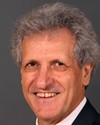Let's just say $15 billion is the initial front-end cost. I'm going to talk about the central Canadian corridor, not the Alberta corridor. Frankly, the Alberta corridor would be significantly less than that--significantly less.
The swing factor would be how much land assembly you would have to do and how much you could arrange through existing corridors. I do not know the answer. If you had to do a lot of original land assembly, it would add a lengthy period of time, number one, and number two, it would certainly escalate the costs at the front end quite significantly.
If you make the assumption that you can do a reasonably efficient job of land assembly, I would say that you would devote the first two to three years to land assembly and securing your corridor and doing all the engineering and other studies that would need to be done in order to launch a very aggressive construction phase.
For the construction phase on something like this, I'm assuming that you would go electric if you really want to do high-speed rail. There are two options on electric. Recent technology says you can put it in the ground; the other choice is to put it overhead, which is the current technology used in most places. Putting it overhead is a bit more expensive, I would think, than putting it in the ground, so that you may be able to save yourself some money, but it's going to take you probably two to three years, minimum, to build that line, even between Montreal and Toronto.
Then you're going to have to do tests and everything else, so you're probably looking at five years of fairly intensive outflow. I would say it would be in the order of $10 billion, at maybe a couple of billion dollars a year, before you'd get to a point at which you could actually start thinking about phasing in an operating system.
Obviously during that same period of time you would also be pursuing procurement activities for rolling stock and other things. You have a whole range of other things to worry about with regard to passenger movement, integration in the stations, and all of that sort of thing. Going on at the same time, of course, would be all the oversight. Transport Canada does oversight of rail construction in this country, and they would certainly be a player in that context from a safety point of view and all of those sorts of things.
That's how I would describe the process, sir. Optimistically speaking, I would say that you'd be looking at six to seven years before you would see a revenue flow.



